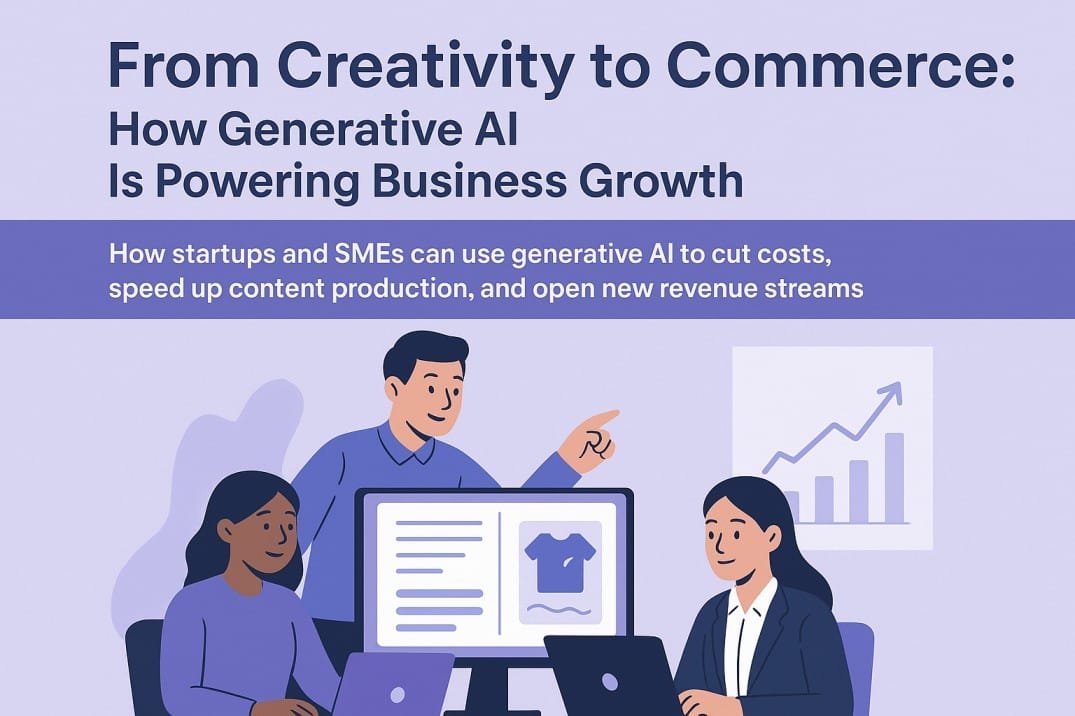The Future of Content Creation: Generative AI for Startups & SMEs
Introduction
Did you know that over 80% of startups experimenting with generative AI report measurable time savings within the first three months? (placeholder stat)
Generative AI has shifted from being a “cool tech demo” to a practical business driver. APIs are now accessible, compute is affordable, and startups can deploy solutions in days instead of months. For SMEs, this means leveling the playing field with bigger competitors — achieving faster launches, better campaigns, and leaner operations.
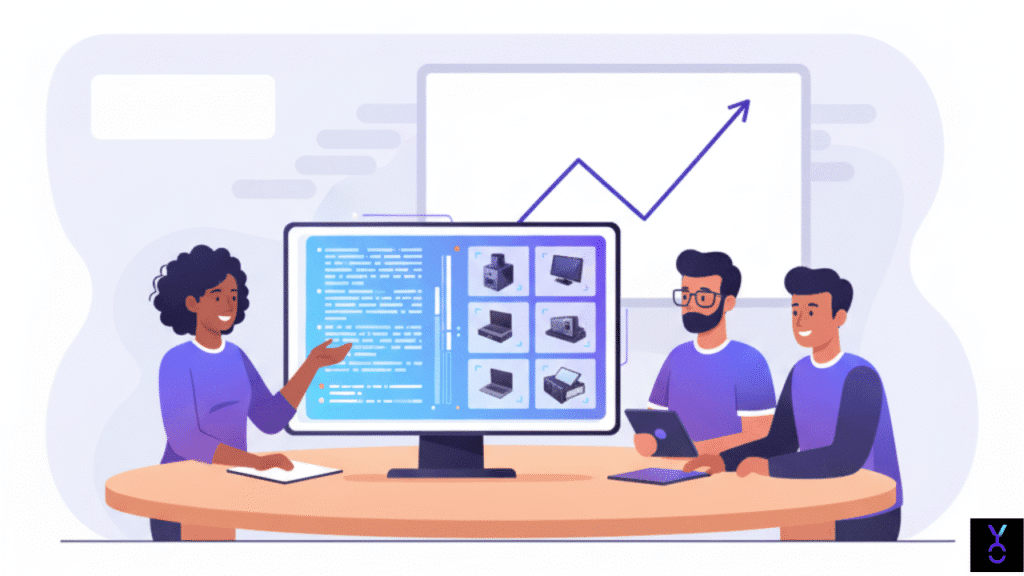
What is Generative AI — A Short Primer
Generative AI refers to systems designed to create original content — from blog posts and marketing copy to product mockups, code, and even training materials.
- Text Models (LLMs): Tools that write, summarize, or draft emails, articles, and scripts.
- Image Models: Generate design concepts, social visuals, and prototypes.
- Multimodal Models: Combine text, images, audio, or video into single outputs.
For startups, this matters because:
- Costs of experimentation are low.
- Iterations are rapid.
- Teams can automate 40–60% of “manual creative work” and redirect resources toward strategy and growth.
Real Business Impact: 5 Practical Use Cases
1. Marketing & Growth
Problem: Campaigns take days to launch, with manual A/B testing of copy.
GenAI Solution: Create 10+ ad copy variants in minutes, generate personalized email subject lines, and adapt tone for different markets.
ROI Example: One SME saw a 15% CTR increase and saved 30+ hours per campaign.
2. Product Design & Prototyping
Problem: Mockups and iterations take weeks.
GenAI Solution: Generate wireframes, UI designs, and multiple variations instantly.
ROI Example: A startup’s sprint planning improved by 20% when AI mockups replaced manual iterations.
3. Customer Support & CX
Problem: Tickets overwhelm teams and delay responses.
GenAI Solution: Draft automated replies, suggest solutions, generate FAQs, and triage issues.
ROI Example: SMEs reduced first-response time by 40%, improving customer retention.
4. Sales Enablement
Problem: Sales teams spend hours writing proposals.
GenAI Solution: Generate pitch decks, proposals, and follow-up templates in minutes.
ROI Example: Deals closed 25% faster by removing proposal delays.
5. Internal Ops & Dev Cycles
Problem: Creating SOPs, training material, and boilerplate code consumes bandwidth.
GenAI Solution: AI creates documentation, training slide decks, and code scaffolding.
ROI Example: Engineering saved 15% sprint capacity.
Pull Quote Callout:
“Generative AI lets startups test 10x more creative ideas in the same time it used to take to test one.”
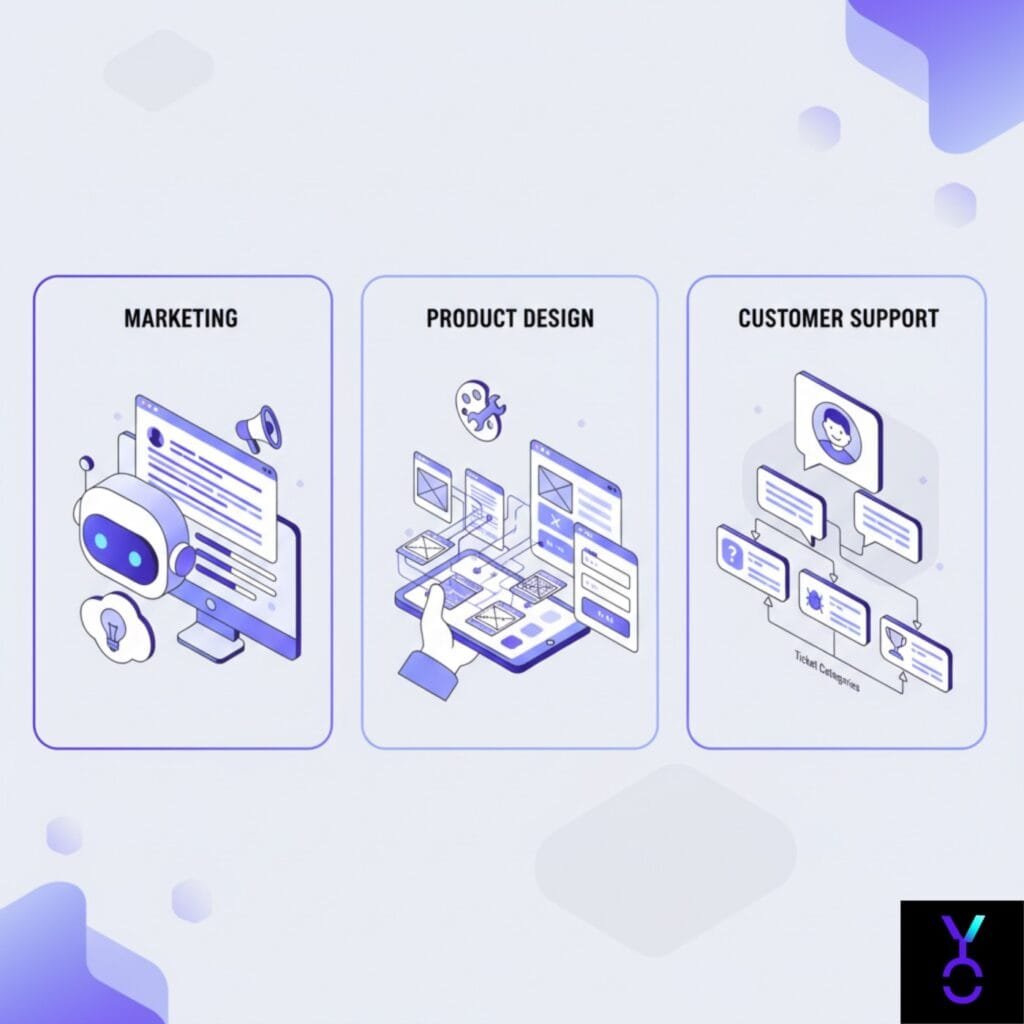
A Practical Adoption Roadmap for Startups & SMEs
Phase 0 — Opportunity Scan
Identify three workflows with clear ROI potential (time savings, cost reduction, or revenue uplift).
Phase 1 — Proof of Concept (4–6 Weeks)
Select a single use case and track metrics like CTR improvement, hours saved, or conversion uplift.
Checklist: POC Success Metrics
- Define one success metric
- Prepare clean sample data (anonymized)
- Run a 4–6 week test with human oversight
- Measure and iterate
Phase 2 — Pilot & Iterate
Deploy to a small team. Collect user feedback, adjust brand tone, and add safety checks.
Phase 3 — Scale & MLOps
Automate monitoring, add drift detection, optimize costs, and build governance frameworks.
Pull Quote Callout:
“Start small: a single well-scoped pilot beats 10 vague experiments.”
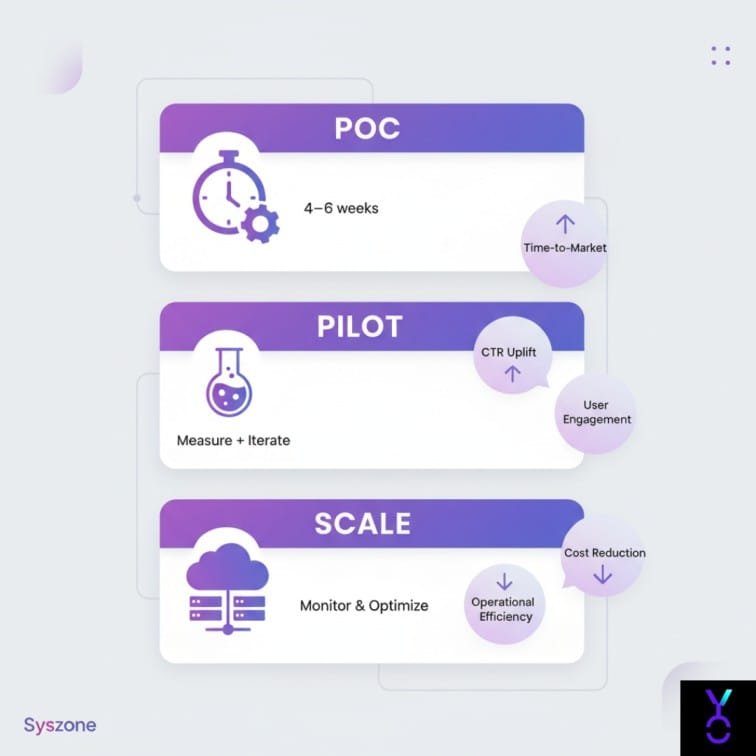
Tools, APIs & Cost-Conscious Stack for 2025 (Quick Guide)
- Hosted LLMs: Hugging Face, Cohere, Replicate
- Image APIs: Stability AI, Replicate
- Affordable Compute: Colab, Paperspace
- Vector Databases: Pinecone, Weaviate
Tips:
- Start with free/low-cost token tiers.
- Use caching to cut API costs.
- Test small before scaling.
Security Note: Always scrub PII, test with synthetic data, and keep audit logs.
Ethics, Brand Safety & Governance — Do This First
Scaling AI without safeguards risks brand trust. SMEs should prioritize governance.
Governance Checklist
- Human-in-the-loop for approval
- Content filters to prevent misuse
- Style guides/templates for brand tone
- Logs for compliance and transparency
Conclusion: Start Small, Measure Fast, Scale Responsibly
Generative AI is here to stay. Startups that adopt it early can achieve faster go-to-market cycles, sharper campaigns, and leaner operations. By beginning with a single proof of concept and scaling responsibly, SMEs can move confidently from creativity to commerce.
Ready to pilot generative AI? Book a free 30-minute discovery call with Syszone AI Solutions.
Recommended Next Steps
- Audit your workflows for 3 high-impact areas.
- Launch a 4–6 week pilot project.
- Establish governance before scaling.
Frequently Asked Questions (FAQs)
Q1. What is generative AI and how is it different from traditional AI?
Generative AI is a type of artificial intelligence that creates original content such as text, images, video, or code. Unlike traditional AI systems, which mostly analyze or classify existing data, generative AI produces new outputs — enabling businesses to automate creative tasks like ad copywriting, design mockups, and customer support responses.
Q2. How can startups and SMEs benefit from generative AI?
Startups and SMEs can use generative AI to:
- Cut marketing costs by generating ad and email variants in minutes
- Speed up product development with AI-assisted design prototypes
- Improve customer support by drafting faster responses
- Create sales proposals and training material automatically
In short, it allows small teams to work with the efficiency of larger enterprises.
Q3. What are some practical use cases of generative AI in business?
The most common use cases include:
- Marketing content automation (ads, blogs, emails)
- Product design mockups and prototyping
- Customer support replies and FAQs
- Sales proposals and presentations
- Internal operations such as SOPs, documentation, and code scaffolding
Q4. Is generative AI affordable for small businesses?
Yes. Many generative AI tools offer free or low-cost tiers, making them accessible even to small teams. Services like Hugging Face, Cohere, Stability AI, or Google Colab allow SMEs to experiment at minimal cost. By starting small and scaling gradually, businesses can stay cost-efficient.
Q5. What risks should businesses watch out for when adopting generative AI?
The main risks include:
- Inaccurate or biased outputs
- Content that doesn’t match brand tone
- Data privacy concerns if sensitive information is shared
- Over-reliance without human review
To mitigate these, SMEs should use human-in-the-loop approvals, brand style guides, and content filters.
Q6. How do I start my first generative AI project?
The recommended approach is:
- Identify 1–2 high-impact areas (e.g., marketing copy or support replies).
- Run a 4–6 week proof of concept (POC) with clear success metrics (time saved, CTR uplift).
- Iterate based on results.
- Scale gradually with governance and monitoring (MLOps).
